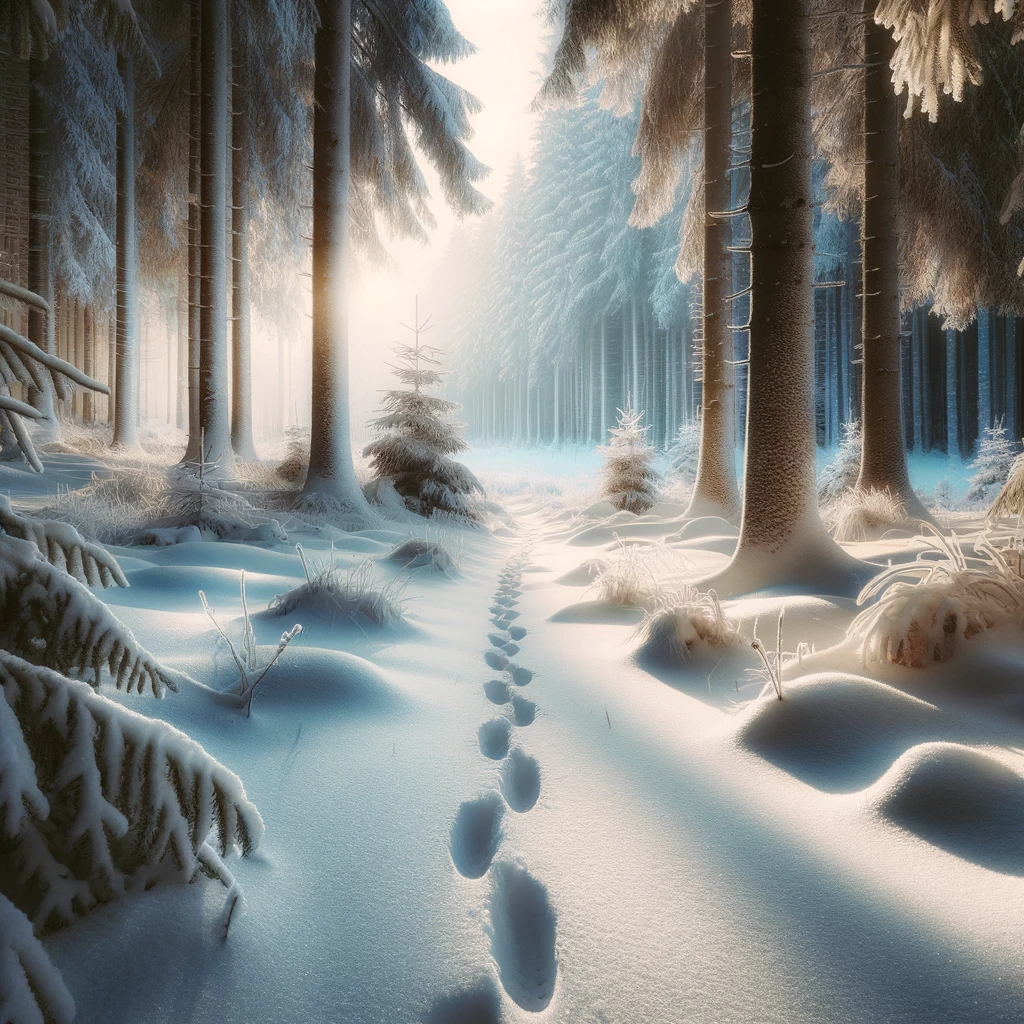Your cart is currently empty!
Winter Whitetails: Mastering December Deer Hunting
Deer hunting in December presents unique challenges and opportunities. As the winter sets in, understanding the behavior of whitetail deer and adapting your strategies is key to a successful hunt. Understanding December Deer Behavior In December, the behavior of whitetail deer undergoes significant changes, primarily driven by the onset of winter. This shift in their…
By.
Share

Deer hunting in December presents unique challenges and opportunities. As the winter sets in, understanding the behavior of whitetail deer and adapting your strategies is key to a successful hunt.
Understanding December Deer Behavior
In December, the behavior of whitetail deer undergoes significant changes, primarily driven by the onset of winter. This shift in their daily habits and patterns is a direct response to the colder temperatures, altered food availability, and, in many regions, increased hunting pressure. For the savvy hunter, understanding these behavioral adaptations is crucial for a successful hunt.
- Winter Adaptations of Deer: As winter sets in, deer focus on conserving energy and maintaining body heat. This leads to them being less active during the colder parts of the day. Deer may seek shelter in denser forested areas or thickets that provide protection against the harsh weather. These areas become prime spots for hunters to focus their efforts.
- Food Sources and Feeding Patterns: With the scarcity of natural food sources in winter, deer change their feeding patterns. They tend to feed during the warmer parts of the day and may travel further in search of food. This quest for sustenance often leads them to more predictable feeding sites, such as remaining green fields or areas where food is supplemented. Understanding these feeding patterns and locations can greatly increase a hunter’s chances of encountering deer.
- Impact of Hunting Pressure: December often falls within various hunting seasons, meaning deer may exhibit heightened wariness due to increased human activity. They become more cautious, often altering their usual paths and timings to avoid hunters. Recognizing signs of hunting pressure and adapting hunting strategies accordingly, such as hunting at less conventional times or in less frequented areas, can be advantageous.
- Tracking in Snow: One advantage of December hunting is the snow cover, which makes tracking deer easier. Fresh tracks can provide valuable information about the size, direction, and recency of deer movement. Analyzing these tracks can lead hunters to active deer trails and bedding areas, increasing the likelihood of a successful hunt.
- Behavioral Cues for Rutting: Depending on the region, some late rutting activity may still be observed in December. Hunters should be aware of signs of rutting, such as rubs on trees and ground scrapes. These can indicate the presence of bucks in the area and their travel routes.
By comprehensively understanding these aspects of deer behavior in December, hunters can refine their strategies to align with the deer’s winter habits. This knowledge not only enhances the chances of a successful hunt but also ensures a more respectful and ethical engagement with the natural patterns of wildlife.
Strategies for December Deer Hunting
Successful deer hunting in December requires adapting to the unique challenges of the season. This period demands a blend of patience, skill, and understanding of the winter environment. Here are key strategies to enhance your hunting success during this time:
- Choosing the Right Hunting Spots: The first step is identifying areas where deer are likely to be active. Look for food sources that are still available in winter, such as acorn-rich oak forests or late-season agricultural fields. Deer also tend to congregate near water sources, which are scarce in winter, making these spots particularly attractive. Additionally, south-facing slopes and areas protected from the wind can be deer hotspots, as they offer warmer environments for feeding and resting.
- Timing Your Hunt: Deer tend to be more active during specific times of the day in December. The best hunting opportunities are often at dawn and dusk when deer move to and from their bedding areas. However, considering the shorter daylight hours, midday hunts can also be productive, especially when deer alter their patterns due to hunting pressure or weather changes.
- Stealth and Camouflage: With the sparse vegetation and potential snow cover, blending into the environment becomes even more crucial. Use camouflage suitable for winter landscapes and practice stealthy movement. Noise and scent control are paramount – deer are highly alert and sensitive to disturbances. Consider wind direction and try to approach hunting areas from downwind to avoid detection.
- Tracking Skills: Snow cover offers an excellent opportunity to track deer. Learn to read deer tracks and sign. Fresh tracks, droppings, and feeding remnants can lead you to active areas. Tracking in snow requires patience and a keen eye for detail, as following a trail can be both challenging and rewarding.
- Adapting to Weather Conditions: December weather can be unpredictable, with sudden changes in temperature and precipitation. Be prepared for varying conditions by dressing in layers and having the necessary gear for warmth and safety. Understanding how different weather conditions affect deer behavior is also crucial. For example, deer might be less active during a heavy snowfall but become more active afterwards when searching for food.
- Use of Deer Calls and Scents: While the rut may be winding down, the use of calls and scents can still be effective, especially for late-season bucks. Experiment with grunt calls or rattling antlers to mimic deer interactions and attract curious bucks. Additionally, using doe scents can entice bucks still looking for mates.
- Ethical Shot Placement: With the challenges of winter hunting, ensuring ethical shot placement is more important than ever. Be patient and wait for a clear, responsible shot. It’s essential to respect the animal and ensure a quick and humane harvest.
By incorporating these strategies, hunters can increase their chances of success in December. Each tactic requires practice and patience, but mastering them will provide a deeper understanding and appreciation of deer hunting in the winter season.
Gear Essentials for Winter Hunting
Hunting in December poses unique challenges, not least of which is dealing with the cold and often unpredictable weather. Having the right gear is not just a matter of comfort; it’s crucial for safety and success in the field. Here’s a breakdown of essential gear for winter deer hunting:
- Layered Clothing: The key to staying warm in the cold is layering. Start with a moisture-wicking base layer to keep sweat away from your skin. Add an insulating layer, like fleece or wool, to retain body heat. Top it off with a waterproof and windproof outer layer. Remember, it’s easier to remove a layer if you get too warm than to add one you didn’t bring.
- Insulated, Waterproof Boots: Your feet are one of the first body parts to feel the cold. Invest in a quality pair of insulated, waterproof boots. Look for boots with a high insulation rating, especially if you’ll be stationary for long periods. Good traction is also important for navigating slippery terrain.
- Warm Gloves and Hat: A significant amount of body heat is lost through the head and hands. Wear a warm hat, preferably one that covers your ears. Gloves should be insulated but also allow for enough dexterity to handle your weapon and other gear. Consider bringing hand warmers for extra warmth.
- Thermal Optics and Sights: Cold weather can affect the performance of optics and electronic gear. Use thermal optics and sights that can withstand low temperatures and provide clear visibility in a variety of light conditions.
- High-Calorie Snacks and Hydration: Your body burns more calories in the cold, so pack high-energy snacks like nuts, jerky, or energy bars. Staying hydrated is also crucial, even in cold weather. Use an insulated water bottle to prevent your drink from freezing.
- Emergency Kit: Safety should always be a priority. Carry an emergency kit that includes first aid supplies, a fire-starting kit, a space blanket for warmth, and a whistle or signal mirror for emergencies. Also, ensure your cell phone is fully charged and protected in a waterproof case.
- Quiet and Insulated Hunting Blind or Stand: If you’re planning to stay in one spot, a hunting blind or stand can provide shelter from the elements. Look for options that are insulated for warmth and designed for noise reduction to keep you concealed.
- Snow Camouflage: In areas with snow, traditional camouflage may not be effective. Consider snow camouflage patterns to blend into the winter environment.
- Backpack with Waterproof Cover: A sturdy backpack is essential for carrying your gear, snacks, and extra clothing. A waterproof cover will protect your items from snow and rain.
Remember, the right gear can make a significant difference in your comfort, safety, and success during December deer hunting. It’s worth investing in quality items that will withstand the harsh winter conditions and enhance your overall hunting experience.
Closing Thoughts: Embracing the December Challenge
As the sun sets on a cold December day, casting long shadows over the snow-covered landscape, it’s time to reflect on the unique experiences that winter deer hunting offers. This final section wraps up our discussion on deer hunting in December, emphasizing the joy and challenges it brings, and encouraging hunters to embrace this special time of year.
- The Beauty of Winter Hunting: There’s a distinct beauty to the winter woods that’s unmatched in other seasons. The quiet, the stark landscapes, and the crisp air provide a serene backdrop for hunting. The challenge of tracking in the snow, the thrill of spotting a deer against the winter white, and the satisfaction of a successful hunt are experiences that stay with a hunter forever.
- Learning and Growth Opportunities: December hunting provides excellent opportunities for personal growth and learning. Adapting to the unique challenges of winter hunting, from tracking in the snow to managing cold-weather gear, enhances your skills and knowledge as a hunter. Each outing is a chance to learn something new about the deer, the environment, and yourself.
- Reflection and Respect: Winter hunting also offers moments for reflection. It’s a time to appreciate the natural world and our place in it. Respecting the deer and the environment, practicing ethical hunting, and being grateful for the opportunity to hunt are essential aspects of the hunting experience.
- Community and Tradition: Hunting in December can be a time to strengthen bonds with fellow hunters and pass down traditions. Sharing stories, experiences, and knowledge with friends, family, or new hunters contributes to the rich tapestry of hunting culture.
- Conservation and Stewardship: Finally, winter hunting underscores the importance of conservation and stewardship. Hunters play a vital role in wildlife management and habitat preservation. By participating in ethical hunting practices and supporting conservation efforts, hunters contribute to the health and balance of our ecosystems.
In conclusion, deer hunting in December is more than just a pursuit of game; it’s an engagement with nature at its most challenging and rewarding. It tests your skills, patience, and resilience, all while offering a unique and profound connection to the natural world. As you pack up your gear and head home, whether with a harvest or not, the experiences and lessons of December hunting are sure to enrich your journey as a hunter.
Share

Leave a Reply